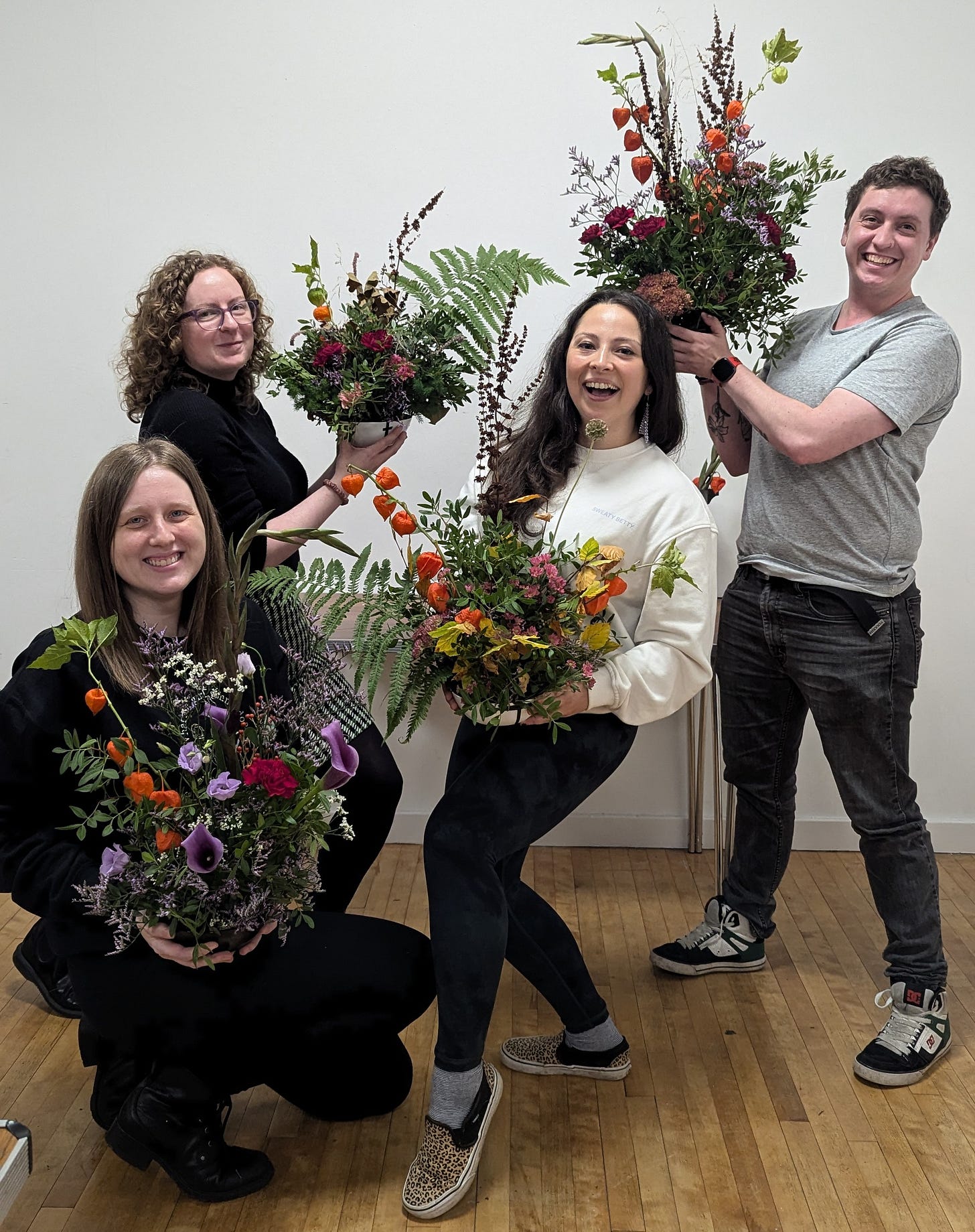This weekend I taught several flower arranging workshops. It's one of my favourite workshops to teach. Seeing the variety of arrangements at the end of a session is always so fascinating. Everyone has access to similar materials, but each final arrangement is totally unique.
I bought in some gorgeous rose hips, Chinese lanterns (Physalis alkekengi) and dark red carnations. An ode to the changing seasons. I tried to forage for some dried bracken. Driving back from Wigtown a few weeks ago took me through the Galloway Forest - the roads were lined with crispy, caramel bracken. But Glasgow's bracken was still looking fresh and green. I got some brown oak leaves and some dried grasses instead.
Despite teaching several different groups, I observed lots of similarities. People would ask similar questions, and people got frustrated by similar things. So I’ve compiled some tips to up your flower arranging game:
Be kind on yourself
Learning a new skill is hard! Being derogatory towards your own skills and abilities won’t make you any happier with your flower arrangement. Enjoy the process and give yourself grace.
Use chicken wire and not foam
Floral foam is simultaneously amazing and utterly awful. It’s great at providing a source of water and holding flowers in place, but it’s terrible for the environment. I never teach using it.
I use a variety of different mechanics, my favourite for flower arranging is chicken wire. Using chicken wire means you can mould the shape to fit into any receptacle you want to use. I’ve also become to embrace the looser approach to flower arranging that chicken wire allows. When using foam you put a stem into it and it stays put, but with chicken wire there can be some movement and some shoogling around. It allows more freedom.
Add fresh water every day
Everyone wants to know the secret to keeping flowers fresh. My best tip is to change the water every day. When I offer this advice to people they often seem a little disappointed, as though there’s some incredible secret that only florists know. It’s as boring and as annoying as keeping the water clean. Ultimately, the flowers have been cut from a plant and they’re now against the clock. I find this fleetingness adds to their beauty.
I don’t use flower food, I keep them out of direct sunlight and if I crank up the heating then I know the flowers will deteriorate quicker.
Use the rule of three
For small arrangements I always start by using three focal flowers. I’ll create a triangle with them. Someone in one of my workshops explained that the reason the human eye finds triangles so appealing is because they mimic the eyes and lips of a face. Who knows if it’s true, but start with three flowers and go from there.
Let the flowers lead you - you can’t control them
As an extension to what I was saying about flower foam and chicken wire, let the flowers dictate the shape of your arrangement. Allow some movement and freedom into your design. The Chinese lanterns were really popular in my classes, but each stem was a bit wiggly and wonky and all the ‘lanterns’ were slightly different shapes and sizes. This is the joy of flowers. The people who embraced the naturalness of the flowers got more enjoyment.
The ones who wanted a stem to be straighter or look a specific way found it harder. All you can do is choose your materials carefully and look for ones that you think will suit your arrangement. I like to embrace the chaos, though. Before deciding how my arrangement will look I’ll study what the flowers look like, which way they lean, and then decide where to place them. I used to spend my weekends wiring the heads of germinis in a flower shop, I don’t bother now I run my own business. If the stem wants to curve, I let it. Trying to control the flowers feels wrong.
Forage for greenery
I love greenery. I know it’s cool now to use only flowers, but it’s not my vibe. If I could, I’d put ivy in every single design I made. If you have access to a garden then snipping a few pieces of foliage can add lots of texture and loveliness to your arrangements. You can also forage - please be courteous and always ask the permission of the landowners. Where I live in Glasgow has lots of bin lanes behind the buildings and these are full of ivy and brambles. No one cares if I snip a piece here and there.
Yours doesn't have to be the same
If you’re flower arranging in a group and your neighbour is using different materials or making an arrangement that looks very different to yours - it doesn’t matter. When you’re flower arranging at home this is less of a problem. But comparison is really the thief of joy. It might be tempting, but don’t open Pinterest or Instagram to try and copy someone’s design. You can make whatever you want.
Leave room for the butterflies
I wrote about this back in May. You can read it here.
Are there any top tips you’d like to share? Or would you like to pick my brains about flower arranging? Leave me a comment and I’ll get back to you.
If you'd like more in depth advice I'll be running workshops in Spring or you can buy my Flower Arranging at Home eBook.
With love,
P.S. Do you want to make a wreath this winter? I’m running several wreath making workshops in Glasgow. A couple of dates are already sold out. Book your ticket on Eventbrite.








